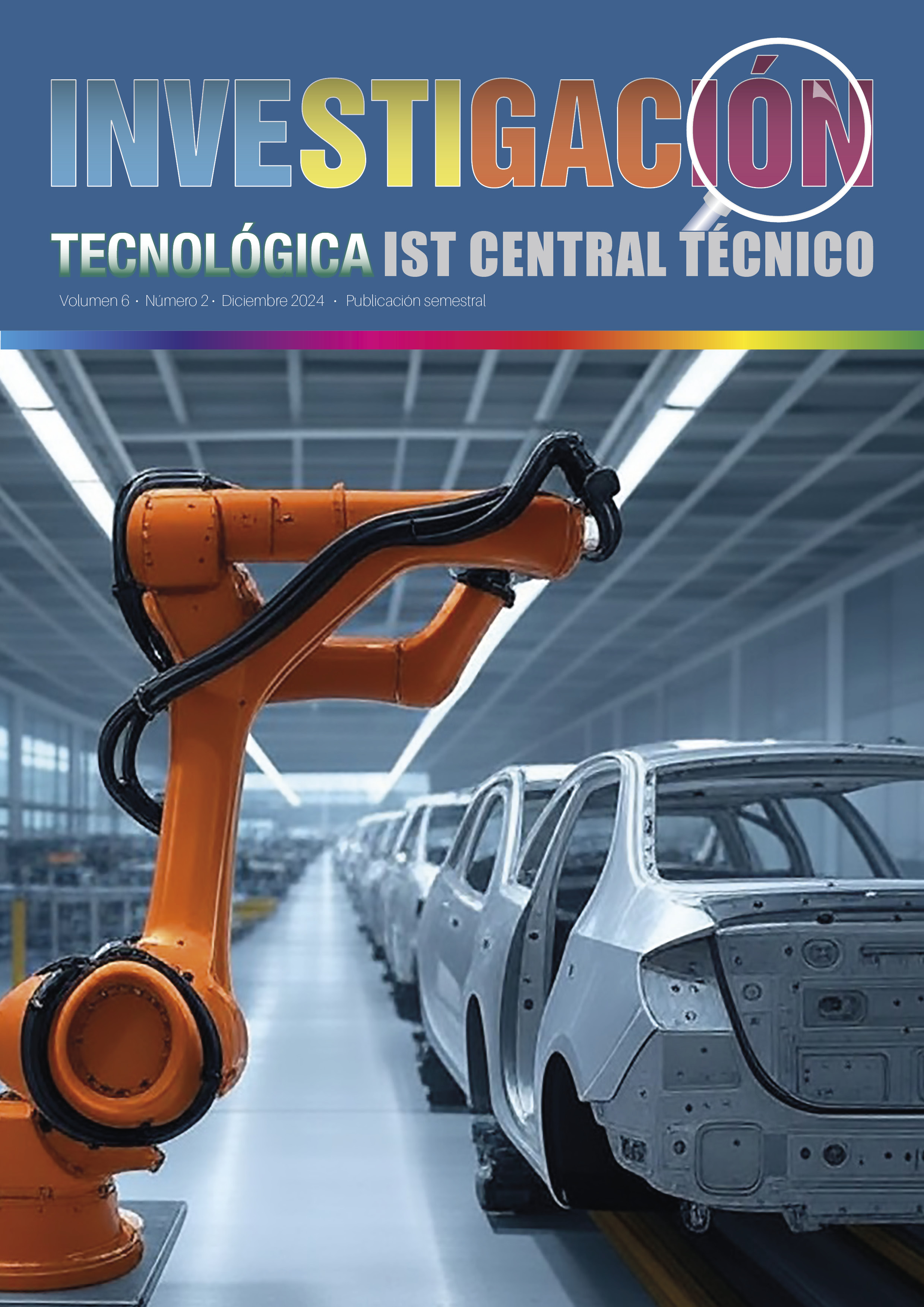Evaluation and conditioning of general lighting levels in the mechanical forming workshop of the industrial mechanic’s course
Evaluación y condicionamiento de niveles de iluminación general en el taller de conformado mecánico de la carrera de mecánica industrial
DOI:
https://doi.org/10.70998/itistct.v6i2.178Keywords:
Decreto ejecutivo 2393, flujo luminoso, lux, luxómetro, niveles de iluminación.Abstract
The research is conducted in the Mechanical Forming workshop of the Industrial Mechanics program at Central Technical University Institute. The main objective is to analyze and compare compliance with current lighting levels according to Ecuadorian and European regulations. For this purpose, field research and the grid method are employed, measuring lighting levels on three planes (floor, general, and workspace), dividing the workshop into 9 quadrants and across four different times of day using a lux meter. The results obtained range from 67.79 lux to 93.34 lux, indicating that the workshop does not meet the minimum lighting requirements established in Executive Decree 2393 (between 300 to 500 luxes). It is proposed to replace low-power LED luminaires with LED lamps providing higher luminous flux; after carrying out the necessary calculations, it is determined that a total of 13 lamps are required with a power of 200W Subsequently, the lighting was remeasured, thus verifying that the workshop complies with the regulations, reaching a level of 528.97 lux.
References
Asociación Española de Normalización UNE. (09 de 03 de 2022). UNE-EN 12464-1:2022. Recuperado el 2023, de UNE: https://www.une.org/encuentra-tu-Asociación Española de Normalización UNE. (2012). UNE-EN 12464-1:2022. Obtenido de https://www.une.org/encuentra-tu-norma/busca-tu-norma/norma?c=N0068596
Asociación Española de Normalización UNE. (09 de 03 de 2022). UNE-EN 12464-1:2022. Recuperado el 2023, de UNE: https://www.une.org/encuentra-tu-norma/busca-tu-norma/norma?c=N0068596
Blasco, P. (2016). Apuntes: Iluminación. Recuperado el 2023, de RiuNet: https://riunet.upv.es/bitstream/handle/10251/75442/ILUMINACION__GIE-3__2en1.pdf
Blasco, P. (s.f). Apuntes: Iluminación. Obtenido de RiuNet: Universitat Politécnica de Valéncia
Blasco, P. (s.f). Universitat Politécnica de Valéncia. Recuperado el 2023, de https://riunet.upv.es/bitstream/handle/10251/75442/ILUMINACION__GIE-3__2en1.pdf
Castro, A. (20 de 08 de 2018). Método para la determinación del factor de reflección in situ de superficies. Recuperado el 2023, de http://opac.pucv.cl/pucv_txt/txt-6000/UCC6141_01.pdf
García, G., Martin, J., Ruíz, J., Ramos, A., Barbero, J., & Gómez, J. (2003). Iluminación y seguridad laboral. MAPFRE. Recuperado el 2024
García, J. (s.f). Cálculo de instalaciones de alumbrado. Recuperado el 2023, de Universitat Politécnica de Catalunya: https://recursos.citcea.upc.edu/llum/interior/iluint2.html
GreenIce. (2024). ¿Cómo Seleccionar Las Lámparas De Acuerdo A La Zona Que Se Desea Iluminar? Obtenido de GREENICE.
Instituto Ecuatoriano de Seguridad Social Seguro General de Riesgos del Trabajo. (1986). Decreto Ejecutivo 2393. Obtenido de https://www.gob.ec/regulaciones/decreto-ejecutivo-2393
Instituto Ecuatoriano de Seguridad Social Seguro General de Riesgos del Trabajo. (17 de 11 de 1986). Gob.ec. Recuperado el 2023, de https://www.gob.ec/regulaciones/decreto-ejecutivo-2393
Miranda, E., Sevilla, S., López, A., & Guanoluisa, D. (27 de 01 de 2020). Evaluación niveles de iluminación en interiores y cálculo para instalaciones de alumbradoEvaluation of interior lighting levels and calculation for lighting facilities. Knowledge E. doi:http://dx.doi.org/10.18502/keg.v5i2.6215
Pugo, C. (05 de 2019). Estudio de iluminación natural y artificial en la Biblioteca de la Universidad Politécnica Salesiana sede Cuenca. Obtenido de Universidad Politécnica Salesiana: https://dspace.ups.edu.ec/handle/123456789/17316
Riva, A. (s.f.). Mediciones de iluminación por el método de la cuadrícula. Recuperado el 2023, de CIE: https://cie.gov.ar/web/images/Metodo-cuadricula-HyST.pdf
Sánchez, C. (16 de 07 de 2012). GUÍA PRÁCTICA SOBRE ILUMINACIÓN EN EL AMBIENTE LABORAL-SRT-RES 084/12-ARGENTINA. Obtenido de Higiene y Seguridad Laboral: https://higieneyseguridadlaboralcvs.wordpress.com/2012/07/16/guia-practica-sobre-iluminacion-en-el-ambiente-laboral-srt-res-08412-argentina/
Subjective and objective survey of office lighting: effects on alertness, comfort, satisfaction, and safety. (28 de 06 de 2022). Med Lav, 113(3). Obtenido de https://www.mattioli1885journals.com/index.php/lamedicinadellavoro/article/view/12371
SYLVANIA. (2020). Guía Técnica de Iluminación . Obtenido de Sylvania Ecuador: https://sylvania.com.ec/catalogos/
Yan, Y., & Mushobozi, J. (14 de 11 de 2019). Effects of Lighting Quality on Working Efficiency of Workers in Office Building in Tanzania. Wiley . doi:https://doi.org/10.1155/2019/3476490
Zhang, R., Campanella, C., Aristizábal, S., Jamrozik, A., Zhao, J., & Ly, S. (2 de 10 de 2020). Impacts of Dynamic LED Lighting on the Well-Being and Experience of Office Occupants. International Journal of Environmental Research and Public Health. doi:https://doi.org/10.3390/ijerph17197217

Downloads
Published
How to Cite
Issue
Section
License
Copyright (c) 2024 Edison García Sigcha

This work is licensed under a Creative Commons Attribution-NonCommercial 4.0 International License.
COPYRIGHT
The ISTCT Technological Research journal is an Open Access publication, whose contents are disseminated under a Creative Commons Attribution-Non-Commercial license (CC-BY NC 4.0 International). All articles published in the ISTCT Technological Research journal are published in Open Access and are available online for free immediately after publication.
This journal provides metadata for third-party indexing services through the open files initiative.
The ISTCT Technological Research journal recognizes and respects the moral rights of the authors, as well as the ownership of the patrimonial right, which will be transferred non-exclusively to the journal to allow its legal dissemination in Open Access.
The ISTCT Technological Research journal does not reserve the rights to publish articles. Authors may distribute their own material in any other medium or medium, as long as it is for non-commercial purposes, informing the editors that the work will be published again and giving the corresponding credit to the ISTCT Technological Research journal.
Authors can make other independent and additional contractual agreements for the distribution of the article published in this journal (e.g., include it in an institutional repository or publish it in a book) as long as they clearly indicate that the work was published for the first time in "ISTCT Technological Research Magazine". In the case of reproduction, a note similar to the following must be included:
"This text was originally published in REVISTA DE INVESTIGACIÓN TECNOLÓGICA ISTCT N ° -, section -----, number of pages, year of publication."
Authors are recommended to publish their work on the Internet (for example on institutional or personal pages) in the final version published by REVISTA DE INVESTIGACIÓN TECNOLÓGICA ISTCT, as it may lead to a greater and faster dissemination of the published work (see The Effect of Open Access).
The publications in this magazine, due to their free nature, do not entitle the authors to any financial remuneration.


